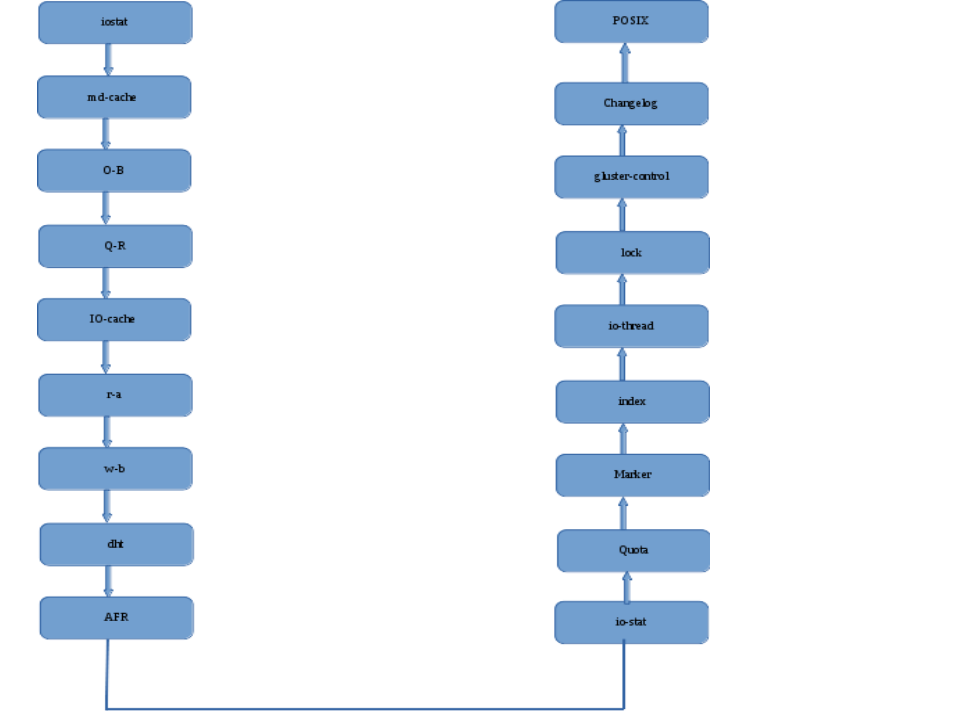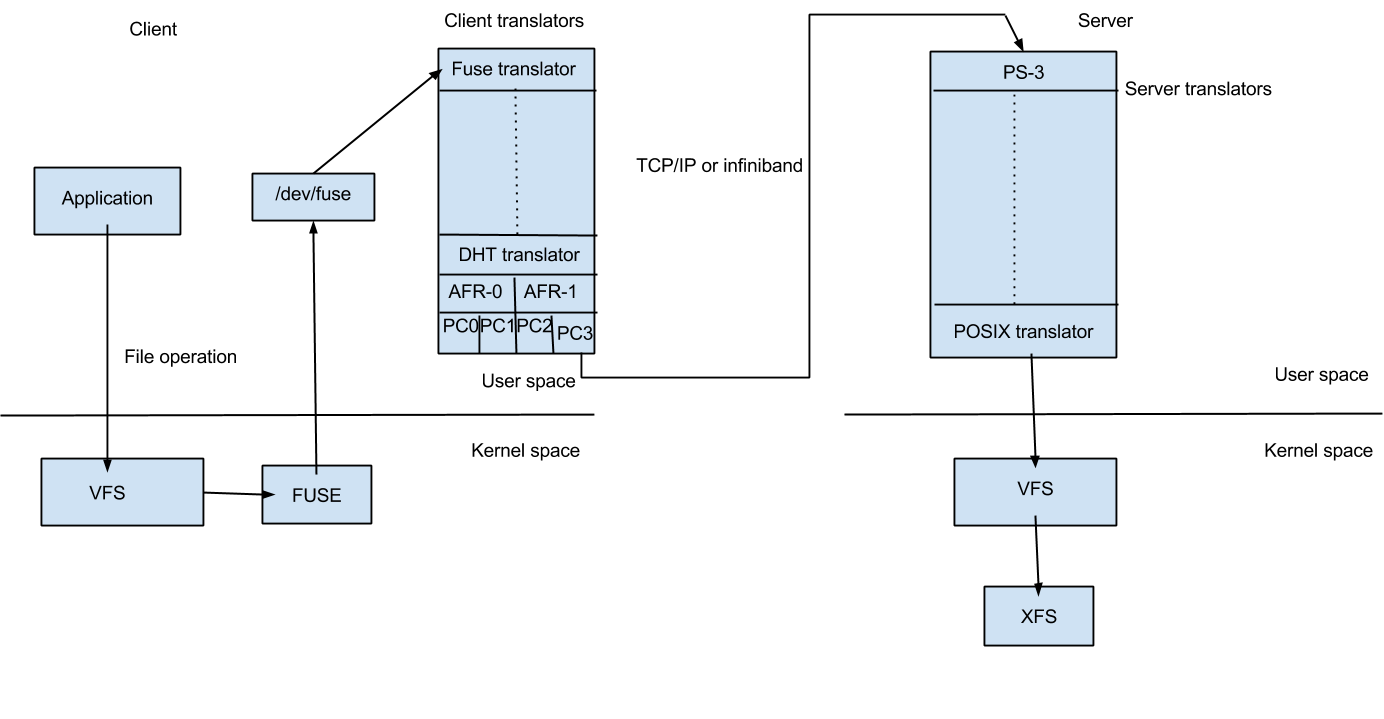glusterfs 主要有以下几个组件
gluster 命令行。
glusterd 管理进程。
glusterfsd 服务进程。
glusterfs 客户端 fuse 进程。
glusterfs 是靠 translator 做分层设计的,类似于可插拔的模块的概念,对应的结构体是 xlator_t,因为是 C 写的,一些面向的对象的写法也是通过 xlator 实现的,可以理解 xlator 是类,具体的实现是对象。比如 protocol/client 是最后的 xlator 从客户端发送到网络,对应的 storage/posix 是服务端接受的最后一层交给服务器上的文件系统。每个 xlator 都会编译成一个单独的 .so 文件。通过指定配置文件可以把不同的 xlator 进行组装,加载 .so 以后,通过dlsym 查找 xlator 的符号(函数表),相当于获取 xlator 的公开接口。配置文件中的 volume 和 subvolume 对应了 xlator 的组织关系。
volfile 会配置在 /var/lib/glusterd/vols/ 下面,对应的文件名是 volfile-id 选项指定的。xlator_t 定义在 libglusterfs/src/xlator.h 里面。下面这张图就可以看到各个 translator 的关系。
glusterfsd 最开始是 protocol/server 最后是 storage/posix 两个 xlator 作为开头和结束。
glusterfs (client) 是以protocol/client 结尾。
那个 write-behind 应该对应的是缓存策略里面的 write back,异步写,而不是直写。
这种设计的好处是方便扩展,你只要填补 xlator 的实现,编译成 .so ,放到链接目录下面,就可以加载进去,不用改整个 glusterfs 的代码。
glusterfs 的整个应用的结构也可以看一下。
用户态是 fuse 实现的文件系统,通过网络协议走到 server,server 本身用的是本地的文件系统,glusterfs 推荐使用 xfs。
下面举个详细的例子。
以 writev 举例,(write 的本质也是 writev,这里的 v 指的是内存向量,写的时候用链表表示的内存向量可以减少内存的拷贝,因为要分配一段连续的内存,然后拷到一起很没有效率,而且系统调用本身也支持这个系统调用,走到底层是硬件支持的,硬件不支持,也能 hook 帮你再拷贝到一起,但上层就不用管这些细节了),他们的调用关系通过 STACK_WIND 和 STACK_UNWIND 实现,对于所有的 xlator 的 op 都是这种调用关系,本身一层结束以后通过调用 STACK_WIND 调用下一层对应的 op,然后在调用完成之后通过 STACK_UNWIND 回调 op_cbk,并且这种调用关系是树状的。
这张图解释挺好的,说明了 xlator 向下传递的过程,通过 STACK_WIND 调用下一层,通过 STACK_UNWIND 调用上一层的 cbk。
glusterfsd 每个 volume 都会起一个线程来处理。
./xlators/mount/fuse/src/fuse-bridge.c 下面是 fuse 的接口,这是客户端的入口,作为文件系统的“桥接点”,大概是为什么叫 bridge 的原因吧。
1 2 3 4 5 6 7 8 9 10 11 12 13 14 15 16 17 18 19 static fuse_handler_t *fuse_std_ops[FUSE_OP_HIGH] = { [FUSE_LOOKUP] = fuse_lookup, [FUSE_FORGET] = fuse_forget, [FUSE_GETATTR] = fuse_getattr, [FUSE_SETATTR] = fuse_setattr, [FUSE_READLINK] = fuse_readlink, [FUSE_SYMLINK] = fuse_symlink, [FUSE_MKNOD] = fuse_mknod, [FUSE_MKDIR] = fuse_mkdir, [FUSE_UNLINK] = fuse_unlink, [FUSE_RMDIR] = fuse_rmdir, [FUSE_RENAME] = fuse_rename, [FUSE_LINK] = fuse_link, [FUSE_OPEN] = fuse_open, [FUSE_READ] = fuse_readv, [FUSE_WRITE] = fuse_write, [FUSE_STATFS] = fuse_statfs, [FUSE_RELEASE] = fuse_release, [FUSE_FSYNC] = fuse_fsync,
看一下 fuse_write,传了一个 xlator_t ,这个东西是 glusterfs 的分层设计的核心,每个 fuse_in_header_t 和 msg 还有 iobuf 都是 fuse 的 API。
1 2 3 4 5 6 7 8 9 10 11 12 13 14 15 16 17 18 19 20 21 22 23 24 25 26 27 28 29 30 31 32 33 34 35 36 37 38 39 40 41 42 43 44 45 46 47 48 49 50 51 static void fuse_write (xlator_t *this, fuse_in_header_t *finh, void *msg, struct iobuf *iobuf) { struct fuse_write_in *fwi =struct fuse_write_in *) (finh + 1 ); fuse_state_t *state = NULL ; fd_t *fd = NULL ; #if FUSE_KERNEL_MINOR_VERSION >= 9 fuse_private_t *priv = NULL ; priv = this->private; #endif GET_STATE (this, finh, state); fd = FH_TO_FD (fwi->fh); state->fd = fd; state->size = fwi->size; state->off = fwi->offset; #if FUSE_KERNEL_MINOR_VERSION >= 9 state->io_flags = fwi->flags; #else state->io_flags = fwi->write_flags; #endif fuse_resolve_fd_init (state, &state->resolve, fd); #if FUSE_KERNEL_MINOR_VERSION >= 9 priv = this->private; if (priv->proto_minor >= 9 && fwi->write_flags & FUSE_WRITE_LOCKOWNER) state->lk_owner = fwi->lock_owner; #endif state->vector .iov_base = msg; state->vector .iov_len = fwi->size; state->iobuf = iobuf; fuse_resolve_and_resume (state, fuse_write_resume); return ; }
首先是传入了写入文件的描述符,要写的内存的段的地址和大小,iobuf 这个结构体和内核里的 iobuf 是查不多的。然后进到 fuse_resolve_and_resume,这个函数主要是解析一些文件的元数据,并且返回到 writev_resume 这个回调函数上,解析的函数在 ./xlators/mount/fuse/src/fuse-resolve.c 下面,这整个是个状态机的写法,主要是解析 fd,父路径,inode 等信息。
1 2 3 4 5 6 7 8 9 10 11 12 13 14 15 16 17 18 19 20 21 22 23 24 25 static int fuse_resolve (fuse_state_t *state) { fuse_resolve_t *resolve = NULL ; resolve = state->resolve_now; if (resolve->fd) { fuse_resolve_fd (state); } else if (!gf_uuid_is_null (resolve->pargfid)) { fuse_resolve_parent (state); } else if (!gf_uuid_is_null (resolve->gfid)) { fuse_resolve_inode (state); } else { fuse_resolve_all (state); } return 0 ; }
到了回到调 fuse_write_resume 上,包了一层引用计数就往下传了。
1 2 3 4 5 6 7 8 9 10 11 iobref_add (iobref, state->iobuf); gf_log ("glusterfs-fuse" , GF_LOG_TRACE, "%" PRIu64": WRITE (%p, size=%" GF_PRI_SIZET", offset=%" PRId64")" , state->finh->unique, state->fd, state->size, state->off); FUSE_FOP (state, fuse_writev_cbk, GF_FOP_WRITE, writev, state->fd, &state->vector , 1 , state->off, state->io_flags, iobref, state->xdata); iobref_unref (iobref);
fuse_writev_cbk 里面 send_fuse_obj 把 iobuf发送出去。send_fuse_data 到 send_fuse_iov,
然后走整个的 xlator 的 writev 调用链,到 client 上,这里最主要的就是 submit_request 开始走网络 rpc 了。
1 2 3 4 5 6 7 8 9 10 11 12 13 14 15 16 17 18 19 20 21 22 23 24 25 26 27 28 29 30 31 32 33 34 35 36 37 38 39 40 41 42 43 44 45 46 47 48 49 50 51 52 53 int32_t client3_3_writev (call_frame_t *frame, xlator_t *this, void *data) { clnt_args_t *args = NULL ; clnt_conf_t *conf = NULL ; gfs3_write_req req = {{0 ,},}; int op_errno = ESTALE; int ret = 0 ; if (!frame || !this || !data) goto unwind; args = data; conf = this->private; ret = client_pre_writev (this, &req, args->fd, args->size, args->offset, args->flags, &args->xdata); if (ret) { op_errno = -ret; goto unwind; } ret = client_fd_fop_prepare_local (frame, args->fd, req.fd); if (ret) { op_errno = -ret; goto unwind; } ret = client_submit_request (this, &req, frame, conf->fops, GFS3_OP_WRITE, client3_3_writev_cbk, args->iobref, args->vector , args->count, NULL , 0 , NULL , (xdrproc_t )xdr_gfs3_write_req); if (ret) { gf_msg (this->name, GF_LOG_WARNING, 0 , PC_MSG_FOP_SEND_FAILED, "failed to send the fop" ); } GF_FREE (req.xdata.xdata_val); return 0 ; unwind: CLIENT_STACK_UNWIND (writev, frame, -1 , op_errno, NULL , NULL , NULL ); GF_FREE (req.xdata.xdata_val); return 0 ; }
回调就会开始释放内存等等操作,这里就略过了,这里回到 fuse 的 writev_cbk
1 2 3 4 5 6 7 8 9 10 11 12 13 14 15 16 17 18 19 20 21 22 23 24 25 26 27 28 29 30 31 32 33 34 35 36 37 38 static int fuse_writev_cbk (call_frame_t *frame, void *cookie, xlator_t *this, int32_t op_ret, int32_t op_errno, struct iatt *stbuf, struct iatt *postbuf, dict_t *xdata) { fuse_state_t *state = NULL ; fuse_in_header_t *finh = NULL ; struct fuse_write_out fwo =0 , }; state = frame->root->state; finh = state->finh; fuse_log_eh_fop(this, state, frame, op_ret, op_errno); if (op_ret >= 0 ) { gf_log ("glusterfs-fuse" , GF_LOG_TRACE, "%" PRIu64": WRITE => %d/%" GF_PRI_SIZET",%" PRId64"/%" PRIu64, frame->root->unique, op_ret, state->size, state->off, stbuf->ia_size); fwo.size = op_ret; send_fuse_obj (this, finh, &fwo); } else { gf_log ("glusterfs-fuse" , GF_LOG_WARNING, "%" PRIu64": WRITE => -1 gfid=%s fd=%p (%s)" , frame->root->unique, (state->fd && state->fd->inode) ? uuid_utoa (state->fd->inode->gfid) : "nil" , state->fd, strerror (op_errno)); send_fuse_err (this, finh, op_errno); } free_fuse_state (state); STACK_DESTROY (frame->root); return 0 ; }
send_fuse_obj 是一个宏实际上是 send_fuse_data,把 fuse_write_out 传给 fuse 告诉 fuse 写出了多少,或者返回错误给 fuse。
1 2 #define send_fuse_obj(this, finh, obj) \ send_fuse_data (this, finh, obj, sizeof (*(obj)))
整个的分析过程大概是从客户端的角度来看的,glusterfs 比较重要的一个 xlator 就是 dht xlator,distributed hash table,这个 xlator 决定了文件的分布。


